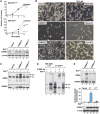3'UTR elements inhibit Ras-induced C/EBPβ post-translational activation and senescence in tumour cells
- PMID: 21804532
- PMCID: PMC3173785
- DOI: 10.1038/emboj.2011.250
3'UTR elements inhibit Ras-induced C/EBPβ post-translational activation and senescence in tumour cells
Abstract
C/EBPβ is an auto-repressed protein that becomes post-translationally activated by Ras-MEK-ERK signalling. C/EBPβ is required for oncogene-induced senescence (OIS) of primary fibroblasts, but also displays pro-oncogenic functions in many tumour cells. Here, we show that C/EBPβ activation by H-Ras(V12) is suppressed in immortalized/transformed cells, but not in primary cells, by its 3' untranslated region (3'UTR). 3'UTR sequences inhibited Ras-induced cytostatic activity of C/EBPβ, DNA binding, transactivation, phosphorylation, and homodimerization, without significantly affecting protein expression. The 3'UTR suppressed induction of senescence-associated C/EBPβ target genes, while promoting expression of genes linked to cancers and TGFβ signalling. An AU-rich element (ARE) and its cognate RNA-binding protein, HuR, were required for 3'UTR inhibition. These components also excluded the Cebpb mRNA from a perinuclear cytoplasmic region that contains activated ERK1/2, indicating that the site of C/EBPβ translation controls de-repression by Ras signalling. Notably, 3'UTR inhibition and Cebpb mRNA compartmentalization were absent in primary fibroblasts, allowing Ras-induced C/EBPβ activation and OIS to proceed. Our findings reveal a novel mechanism whereby non-coding mRNA sequences selectively regulate C/EBPβ activity and suppress its anti-oncogenic functions.
Conflict of interest statement
The authors declare that they have no conflict of interest.
Figures









Comment in
-
C/EBPβ: lost beyond translation.EMBO J. 2011 Sep 14;30(18):3663-4. doi: 10.1038/emboj.2011.288. EMBO J. 2011. PMID: 21915145 Free PMC article.
Similar articles
-
A RAS-CaMKKβ-AMPKα2 pathway promotes senescence by licensing post-translational activation of C/EBPβ through a novel 3'UTR mechanism.Oncogene. 2018 Jun;37(26):3528-3548. doi: 10.1038/s41388-018-0190-7. Epub 2018 Mar 22. Oncogene. 2018. PMID: 29563610 Free PMC article.
-
RasV12-mediated down-regulation of CCAAT/enhancer binding protein beta in immortalized fibroblasts requires loss of p19Arf and facilitates bypass of oncogene-induced senescence.Cancer Res. 2009 Mar 15;69(6):2588-98. doi: 10.1158/0008-5472.CAN-08-2312. Epub 2009 Mar 10. Cancer Res. 2009. PMID: 19276382 Free PMC article.
-
Tumor suppression by RNA from C/EBPβ 3'UTR through the inhibition of protein kinase Cε activity.PLoS One. 2011 Jan 24;6(1):e16543. doi: 10.1371/journal.pone.0016543. PLoS One. 2011. PMID: 21283634 Free PMC article.
-
Regulation of senescence and the SASP by the transcription factor C/EBPβ.Exp Gerontol. 2019 Dec;128:110752. doi: 10.1016/j.exger.2019.110752. Epub 2019 Oct 22. Exp Gerontol. 2019. PMID: 31648009 Review.
-
Stop and go: anti-proliferative and mitogenic functions of the transcription factor C/EBPbeta.Cell Cycle. 2006 May;5(9):953-7. doi: 10.4161/cc.5.9.2733. Epub 2006 May 1. Cell Cycle. 2006. PMID: 16687924 Review.
Cited by
-
RNA Binding Protein CELF2 Regulates Signal-Induced Alternative Polyadenylation by Competing with Enhancers of the Polyadenylation Machinery.Cell Rep. 2019 Sep 10;28(11):2795-2806.e3. doi: 10.1016/j.celrep.2019.08.022. Cell Rep. 2019. PMID: 31509743 Free PMC article.
-
C/EBPβ: lost beyond translation.EMBO J. 2011 Sep 14;30(18):3663-4. doi: 10.1038/emboj.2011.288. EMBO J. 2011. PMID: 21915145 Free PMC article.
-
Positive feedback loop between NRASQ61R mutation and RAB27B expression in endothelial cells.Biochem Biophys Res Commun. 2025 Mar 1;750:151422. doi: 10.1016/j.bbrc.2025.151422. Epub 2025 Jan 31. Biochem Biophys Res Commun. 2025. PMID: 39899936 Free PMC article.
-
Pan-cancer pervasive upregulation of 3' UTR splicing drives tumourigenesis.Nat Cell Biol. 2022 Jun;24(6):928-939. doi: 10.1038/s41556-022-00913-z. Epub 2022 May 26. Nat Cell Biol. 2022. PMID: 35618746 Free PMC article.
-
RNA localization and co-translational interactions control RAB13 GTPase function and cell migration.EMBO J. 2020 Nov 2;39(21):e104958. doi: 10.15252/embj.2020104958. Epub 2020 Sep 18. EMBO J. 2020. PMID: 32946136 Free PMC article.
References
-
- Acosta JC, O’Loghlen A, Banito A, Guijarro MV, Augert A, Raguz S, Fumagalli M, Da Costa M, Brown C, Popov N, Takatsu Y, Melamed J, d’Adda di Fagagna F, Bernard D, Hernando E, Gil J (2008) Chemokine signaling via the CXCR2 receptor reinforces senescence. Cell 133: 1006–1018 - PubMed
-
- Adams PD (2009) Healing and hurting: molecular mechanisms, functions, and pathologies of cellular senescence. Mol Cell 36: 2–14 - PubMed
Publication types
MeSH terms
Substances
Grants and funding
LinkOut - more resources
Full Text Sources
Other Literature Sources
Medical
Molecular Biology Databases
Miscellaneous

